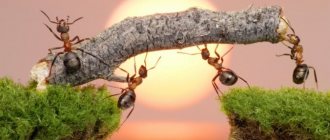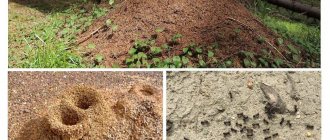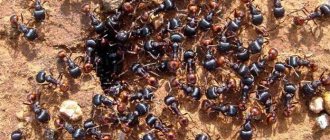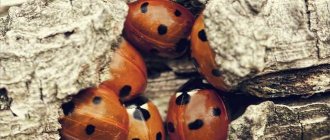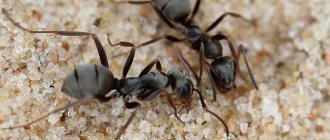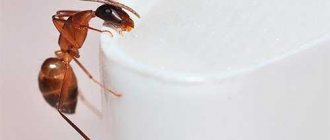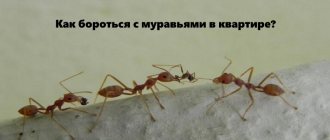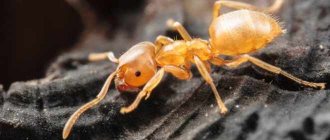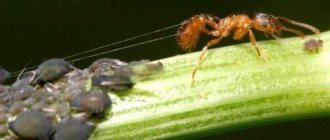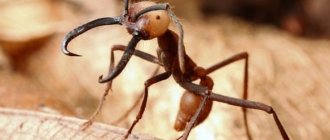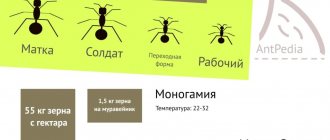Brief description: Description of the main features of ant wintering? How ants overwinter, arrangement of an anthill, food supplies. Features of ant hibernation during the cold season. How do you feel the arrival of heat?
Ants carefully prepare for winter, as this process directly affects their success in surviving the harsh weather conditions of the cold season. In spring, summer and autumn, they expand and deepen their home, storing food supplies, insulating the anthill, not only inside, but also outside.
With the help of an additional top layer of branches and leaves, it is possible to retain heat inside the home. These hardworking insects, when it is still warm, make repairs to their homes, and also take care regarding the release of larval offspring. So, let's figure out how ants winter?
How do ants prepare for the winter?
In order for the ants to have a sufficient amount of food and comfortable wintering conditions, they perform a number of actions, initially they prepare a sufficient amount of food - they collect caterpillars/beetles/bugs/other insects that live in the area, in the forest.
Some of the food is used to feed the larvae, while the rest is stored in special chambers, where they have all the conditions for spending the winter. This allows them to eliminate the need to leave their own “rooms,” thereby preventing the cold from entering the anthill. In addition, their diet includes vegetation, fruits/seeds of garden plants. It is also worth noting such a delicacy as the secretions of live aphids.
The procedure for preparing a house is not complete without insulating it. The ants build a superstructure over the house, forming a dome-shaped mound that provides warmth in winter. It is worth noting that red forest ants make a mound more than one meter wide and 0.5 meters high. This heap contains passages, chambers. Thanks to the collected loose material, the cold cannot get inside.
Adults think about their future legacy, therefore, to preserve the life of the larvae, they are transferred to the warmest possible place and a microclimate that is satisfactory for them, where there will be no sudden changes in temperature.
Prevention
Preventive measures are necessary in order to consolidate the achieved effect and prevent further appearance of ants in the house. With their help, you can get rid of insects in your apartment for many years.
For prevention, the following rules must be observed:
- timely remove all leftovers from meals into a trash bin with a tight-fitting lid;
- do not keep large supplies of food in the house;
- Store cereals, flour, sugar and other products in glass jars closed with lids;
- periodically carry out wet cleaning of the premises and prevent the accumulation of trash and debris.
To repel insects, you can use fragrant herbs, aromatic oils and substances with a strong odor. For example, red ants do not like vinegar, ammonia and laundry soap. They also dislike the aroma of cloves and tobacco smoke.
After removing ants, various odors can be used for prevention. Natural herbs that insects do not like:
- garlic;
- sagebrush;
- geranium;
- mint;
- parsley;
- tomato tops.
After removing the ants, fresh plant branches can be laid out near the places where they appear. The disadvantage of this method is that the leaves quickly wither and the smell disappears.
Garlic contains a record amount of essential oils. It can be used to coat baseboards, cracks in the floor and between tiles. The smell will last a long time.
Ants can't stand the smell of garlic
Fresh lemon slices retain their scent longer than herbs. You need to cut the lemon and place the slices in places where arrogant pests are expected to appear.
We suggest you familiarize yourself with: Do-it-yourself potash fertilizers
Geranium can be grown on a window. It blooms beautifully, its smell calms the nervous system. The flower is among the record holders for purifying the air, especially from tobacco smoke. The leaves can be plucked periodically and coated with the exits from ant holes. The disadvantage of removing insects with herbs is that they must be constantly replaced with fresh ones and the ants gradually become accustomed to one smell. Plants need to be changed.
Essential oils retain their scent for a long time. It is enough to drop mint, lemon oil, garlic extract into the hole, the ants will not walk through that tunnel for a long time.
The pungent smell of essential oils will help get rid of insects
In nature, there is a smell that causes panic in ants. This is formic acid. It can be bought at a pharmacy, synthesized artificially. The substance got its name because it is secreted by ants. Insects transmit many signals to each other, producing different enzymes. Some mark the path.
If you buy a bottle of formic acid, the smell of which a person cannot smell, then just apply it to cotton pads and place it along the baseboards, not a single ant will crawl into the apartment. The leftovers can be placed in a cabinet in the kitchen, just do not close it tightly. Let the smell dissipate a little. For a couple of years or more, the apartment is protected from visiting ants.
Where do ants go in winter and what happens to them in nature?
The ants remain overwintering in the same anthill as during the rest of the year, the only difference is their movement to chambers located at the depths of the dwelling, where the temperature is higher, most often it is 0 degrees.
A stable temperature regime makes it possible to winter without much loss with a measured way of life. If the first layer gets wet, the workers carry the food supply even deeper. Countries with warm winters allow insects to venture outside to search for food.
Traditional methods
In addition to garlic, other means were used to combat the infestation of the apartment with ants. For example, they poured black and red ground pepper near the holes. This way you can gradually destroy the whole family. Small pepper particles stick to the paws. Then into insect food. When it gets into water, its bitterness, burning, and warming effect are activated. The entire nest gradually dies out, even those located deep in the wall and under the floor.
Boric acid is mixed with a boiled egg and boiled potatoes. First, the products are pounded well, then a little honey or sugar is added and all the ingredients are mixed. Roll the resulting mass into balls smaller than a pea. The worker ant should be able to freely pick it up and drag it into the nest.
Boric acid, once in an insect, corrodes it from the inside. Since the ant is able to pick up the ball, it will bring it to the nest, to the residents of the family who do not go outside. It will begin to chew the big one and die before it reaches the nest. It is enough to periodically change the poison for 4–6 weeks with fresh one, and there will be no ants in the house for a long time.
If you mix jam with yeast, pour it onto a cardboard and place it on the path, then the insects will not go further, they will drink, fill their tanks and run back. Once in the ant's stomach, the yeast begins to ferment and release a lot of gas. As a result, the insects simply burst apart like air-filled balloons.
Ants constantly climb through garbage dumps, bringing bacteria and fungus into the apartment. They can become the culprits of disease in humans and animals. In large crowds, bite children. By removing ants, you will protect your home from diseases, dirt, and unpleasant neighborhoods. After all, sneaky people get into food, and it’s unpleasant to finish eating after them.
Tags: what, ant, temperature, die
About the author: admin4ik
« Previous entry
Where do ants go for the winter? Are they sleeping or not? What do they do, what do they eat?
With the onset of cold weather, colonies slow down the pace of their usual life activities. But this does not mean that they stop performing their duties. The uterus practically does not produce offspring. And the larvae, which do not have time to transform into adults, slow down in development.
The queen is transferred to the warmest chamber, and feeding is also started with foods that are rich in protein, due to which she lays trophic eggs (larvae are not born, in this case the eggs are just food).
In winter, certain types of ants enter diapause (hibernation), during which the work of their internal organs slows down. Some of the species are quietly active, but activity is still slightly reduced when compared to warmer weather conditions.
They require less food. They provide food for the larvae. If the soil temperature rises above 0 degrees, the diapause ends, the insects begin to feed the younger generation and further develop housing.
Those ants that live in mild climates come to the surface when the temperature is above zero, continue to prepare reserves, and breed offspring. They navigate due to the fact that the temperature inside the anthill rises, and the daylight hours decrease or increase.
Larvae that live at high altitudes (state of torpor) are able to survive 2 winters and only after that become adults.
Where do they spend the winter?
The chambers where ant larvae overwinter in winter differ from those in summer. Before the onset of cold weather, adult individuals carefully prepare - in order to insulate the house, all holes in it are well sealed with dry grass along with soil. The holes open only for the time when insects need to replenish food supplies. But this is done only when the air temperature rises slightly.
To read: Large cockroaches and how to deal with them
If in winter the upper part of an anthill suddenly gets wet, a special rescue squad drags food supplies into deeper compartments. Insects overwinter in their cozy shelter until March-April. A sign that goosebumps will soon surface will be the laying of eggs by the uterus and the gradual resumption of work activity. In spring, the life of adult individuals becomes active and resumes in full.
Why don't ants freeze?
The presented individuals live even in the north, known for cold temperatures. If we talk about Kamchatka and polar ants, their “rooms” are arranged at a depth of up to 30 centimeters.
Those who live in a temperate climate zone are distinguished by the construction of a dome that warms the anthill. When climbing to the upper floors, the ants immediately feel discomfort, which is why they go down.
They survive thanks to special sugary substances secreted by aphids. Accumulating, sugar turns into glycerol in the insect’s body. Therefore, they can easily tolerate even -50 degrees, but plunging into a state of diapause. Initially, you might think that they are dead, since they do not move at all and do not eat food, but this ends immediately with the arrival of warmth.
It is worth noting that in winter, beetles settle in with the ants, which secrete a sweet secretion, which the owners of the house eat, while guests prefer their prepared reserves.
Repellent Products
One of the foods that ants are afraid of is garlic and its tinctures. They are recommended to be used in the garden, rubbing tree trunks, and in the house.
Other foods that repel ants and aphids:
- Cut onions and garlic are laid out in the house and on ant paths; the infusion of onion peels can be sprayed on the plants.
- Vinegar and essence are used to expel ants from cabbage beds, from the premises of a summer house or home: vinegar is diluted in half with water and ant paths and nests are treated with the solution. Insects do not like the pungent smell, and they leave the home.
- Freshly brewed coffee, or rather its extraction, can be placed near garden plants to repel ants.
- Cinnamon, ground red pepper - used in ground form, placed in insect habitats, or added to herbal decoctions.
- Sunflower oil (preferably unrefined) - what ants in the house are afraid of is the smell of vegetable oil, so it can be used to combat uninvited guests, however, the disadvantage of this method is the presence of greasy stains in the house.
- Millet - the reason why ants don’t like it is unknown, however, by pouring millet into an anthill, you can definitely get rid of them.
Ant Control Products
How long does winter last?
Wintering can last for different periods of time, the main factor influencing this is the climate where the insects live. For example, the species Camponotus sp. It can overwinter for three to five months, but Myrmica sp. 30-60 days are enough; Lasius (Niger) do not hibernate at all of their own accord.
The polar species of ants is distinguished by its wintering period of 8-9 months; the rest of the time they try to feed future heirs, which does not always end successfully, since the region of residence is characterized by a short period of time without snow. Despite this, extreme conditions do not affect their survival.
Those living in warm regions winter during only the two coldest months of the year. The southern inhabitants are lucky, since they rarely hibernate, but despite this, they still prepare for winter, devoting themselves to collecting food, digging tunnels, feeding larvae because of their instincts.
Yeast against ants
Don't know how to get ants out of your apartment? Dry baker's yeast can help with this. You will need one spoon (teaspoon). Yeast is mixed with 100-150 ml of sugar syrup. The resulting product is applied pointwise to the ant paths. They will love this treat. But 10 minutes after consuming the mixture, the process of yeast fermentation will begin, as a result of which the insect’s abdomen will begin to swell, and it will flee. This procedure should be carried out regularly. You can simply pour the mixture into a small, low container.
Distinctive features
Ants can sleep at any time of the day. Despite the fact that during the night the anthill and the outside world interrupt their connection until the morning (the passages are closed), you need to understand that the life of the colony continues to boil inside. If we take into account sleep in the winter season, then insects that hibernate can remain in suspended animation until it warms up and the snow melts.
Scientists have identified a certain feature: the body of an arthropod, which is in hibernation, continues to function, there is only one difference - a slowdown in all functions and functioning of organs.
Thanks to this, ants can preserve the energy resource of their own body, thereby ensuring the need for less food consumption than at normal times. This specific period is an opportunity for the family to survive prolonged cold weather.
Little worker
We all watch in surprise and admiration as a tiny ant drags prey into its house, many times larger than itself. Everyone will envy their hard work and endurance. What is the role of ants in nature?
Beneficial activities of ants
Unexplored paths of little workers
How are ants useful? These insects are associated with a secret society. For millions of years, exchanging an encrypted language, they pave paths unknown to anyone. We are just beginning to know them today. At first glance, the activities of ants seem chaotic and useless. But is it? What benefits do ants bring to the forest and people?
Tiny soil formers
In the process of building their nests, ants loosen the soil, providing more air access to the roots of plants. But this favors their breathing.
This is especially necessary in places where there are heavy clay soil layers.
For example, an earthworm is active up to 20 cm deep, and a garden ant builds an underground house up to one and a half meters deep in 2-3 years with excellent aeration and humidity of more than 90%.
It is reliably known that thanks to the activity of these insects, the amount of potassium in the soil doubles, and phosphorus becomes ten times more. At the same time, it is they who promote the transition of these substances from an insoluble state to a soluble state available for plant nutrition.
Moreover, these insects enrich the soil with substances such as humus, potassium, nitrogen, improving its structure and increasing fertility.
The benefits of ants in seed dispersal
Small seed spreaders
Ants don't just make trails in search of food and building material for their castles. The ant crawls usefully. Do you know what benefits they have in expanding the flora? About 1% of plants, which is approximately 3,000 species, are spread by these insects.
Celandine, hairy gooseberry, goose onion, thyme, corydalis and many others are equipped with special appendages on their seeds that ants love to feast on. Carrying this delicacy home, they spread the seeds several tens of meters around. By the way, only ants spread fragrant violets.
Ant - forest orderly
By destroying dead insects, ants can rightfully be called nurse insects.
In the forest where anthills are located, there are no outbreaks of mass reproduction of insect pests: sawflies, spider mites, cutworms, slugs.
A medium-sized garden anthill can collect up to 2,000 larvae, eggs, caterpillars and other pests in one day. During the same period, the inhabitants of one forest anthill are able to eat more than 17,000 insects, protecting an area of 0.2 hectares.
Nebaiduzha detail of a forest landscape
Murakhi are forest nurses. It’s not for nothing that they are called that. The creepiness in the forest is on a global scale. Instantly following various kinds of larvae on the trees of the goosebump, the stinkers steal the forest from their massive reproduction.
In addition, the goosebumps affected by the disease do not disappear from the goosebumps, but die on their own.
Ant hydrometeorological center
Another feature that can be usefully used by people and borrowed from these insects is the ability to anticipate weather changes. They feel the storm. The day before they go into the anthill and close all the passages.
Ants as prey
The importance of ants in nature is not limited to their activities. They can benefit by sacrificing themselves. What are ants for?
Nutritious food for birds
Ants are food for forest dwellers
Ants are an important link in the food chain. They are a favorite treat for songbirds, badgers
Bears, foxes, black grouse, and hazel grouse feed on them.
Birds “bathe” in anthills, launching insects under their wings and crushing them on their feathers. In this way they eliminate parasites, and, possibly, are cured with formic acid.
Medicine for humans
Modern medical research has proven that many ailments can be prevented by eating ants for a long period of time.
Diseases such as atrophic arthritis, chronic hepatitis, neurosis, insomnia, even dizziness in older people are treated or alleviated by taking these insects.
Why are ants almost a panacea for these ailments? All thanks to proteins and microelements, which ants are rich in. They also contain a considerable amount of formic acid, used in medicine as a stimulant and astringent.
Ant queen
Ants live as a family. This is a highly organized society, consisting of various castes: workers, soldiers, other specialized groups and, of course, queens (reproductive females), of which there may be one or several in one family. In this regard, in ant society there is a division of labor. And it is this fact that has long interested researchers, as it suggests an association with the organization of life in human society.
By the way, many ant families exist for quite a long time: the queen (queen) - up to 20 years, workers - from 1 to 3 years, males - only a few weeks. Many people want to find out what each member of the ant family does? The queen (queen) lays eggs, sometimes she leaves the nest and collects food (this depends on the type of ants).
Males (as in the entire animal world, and there is no exception here) fertilize young females and die after mating. Well, the fate of the males is sad... The third category of members of the ant family is the most numerous and effective - workers. These are mainly females who cannot bear offspring. Since they do all the housework, they differ in size, sensitivity of their sensory organs, and activity.
The queen sometimes leaves the nest when laying eggs.
Their sphere of activity is varied: weaver ants, there are nannies (they look after young individuals), a significant part of the family is engaged in nest construction, forager ants are engaged in prey, there are cleaners, and stock keepers. An ant family can number hundreds of thousands of individuals, but at the same time they all work as a single organism.
We invite you to familiarize yourself with: Raspberry variety Giant, characteristics of agricultural cultivation techniques
And this cannot be surprising. If you decide to find out how ants overwinter in an anthill, then first of all it should be noted that anthills in cold regions are underground, which allows insects to withstand the most unfavorable environmental conditions, including low temperatures. During this period, insects operate in “economy” mode, and the reserves that were collected in the summer are enough for the entire colony.
What does the queen ant look like? In most colonies, the individuals responsible for reproducing offspring are significantly larger in size than ordinary worker insects. The queen can be identified by the presence of wings, which she requires to search for new habitats. However, when moving into a colony, they may disappear. In this case, in the place where the cephalothorax passes into the abdomen, corresponding marks remain in the form of small tubercles.
Bringing out of hibernation
It is necessary to remove the ants slowly so as not to give them hypothermic shock. To do this, gradually raise the temperature over several days, moving the insects to an increasingly warmer place, and to restore strength, prepare protein food for them in advance; a crushed insect is best.
If everything was done correctly, then after a couple of weeks the queen will begin to lay eggs again, which means the wintering was successful. Beginners are still recommended to purchase ants that do without wintering, the types of which are listed in the table at the beginning of the article.
Preparing for cold weather
In the life of an anthill, preparation for winter cold is the most important period. Since spring, all the efforts of the colony are concentrated on preparing resources for wintering and the appearance of young animals before the arrival of frost. It is reliably known that many ants in winter do not go into suspended animation , but lead an active lifestyle, although not the same as in the warm season. How they prepare for winter has been studied by both scientific myrmecologists and amateurs. The main stages of preparation for winter are:
- food preparation;
- insulation of the anthill.
When preparing food for food in winter, insects obtain and bring into their home dry fruits, seeds of various plants, as well as dried parts of the plants themselves . Insects drag the prepared provisions from one place to another all winter, which prevents it from deteriorating in conditions of high humidity, and the insects themselves do not die from hunger.
, eggs laid in summer are also a good help . They are sterile (in other words, trophic) and serve as good feeding during the cold season.
The next step is preparing the winter home. Ants move to the lower floors of the anthill , which are located at a depth of 1.5 to 2 meters, where they are quite comfortable. Constant soil temperature at such a depth promotes wintering in fairly good conditions. To insulate the anthill, insects carry various debris and soil out of it to the surface even before the onset of cold weather. This is necessary in order to cover your home with a so-called fur coat. This is how insects prepare for winter.
After processing
When spraying such purchased products as Combat with Raptor, Clean House, Fumitox and other substances, you should ventilate and clean the foundation as indicated in the instructions. If a decorative layer of plaster or paint is applied to the base, or special slabs are laid, then it is best to wash off the composition after all insects have been destroyed. This will happen approximately within 5 hours.
If there is no decorative coating on the foundation, then you can clean the composition after several days, but it is better not to remove it at all for preventive purposes. Compositions of natural origin, for example, a solution of garlic or potato starch, do not need to be washed off at all. When it rains, it will wash off and be removed from the walls of the building.
Neighbours
In addition to the ants themselves, aphids, beetles, moths, and also the larvae of these insects also live in their home nearby. They are useful for those who secrete a special nutritious and sweet-tasting enzyme that helps ants survive in the cold. Such neighbors themselves eat not only part of the ant reserves, but also their eggs. Many insects and beetles, hiding from severe frosts, find salvation in abandoned dwellings located on the surface of the soil.
Ants have a big sweet tooth. Sometimes it comes to the point that they carry entire colonies of aphids underground and continue to feast on the sweet secretion secreted. True, without fresh food, aphids die within a few weeks, but for some time the ants have the opportunity to taste the products of their vital activity.
In addition to aphids, other insects also inhabit anthills - beetles, moths and their larvae. They also secrete a sweet juice, and they themselves can feed on ant stores or even their eggs. As a result, they help each other survive in the cold season.
Briefly about the main thing
We found out what ants do in winter. If we are not talking about areas with extreme climates, insects continue to live in their usual mode, but less actively. In northern regions, ants and their larvae overwinter in a supercooled state.
We have found the answer to the question whether ants sleep in winter or not. It turns out that the majority of insects do not sleep. Only some species hibernate.
And one more thing - where are the ants in winter. The answer is quite simple - in your own house, but on the lower floors.
Tags: do, winter, ant, nature
About the author: admin4ik
« Previous entry
Do they sleep at night?
So, the life of an ant colony is in full swing around the clock; at night, individual representatives do not sleep, protecting the anthill and caring for the larvae. It is especially important to protect the colony from various external factors, for example, enemies, natural disasters - floods, fires.
When a threat appears, adults exhibit an immediate reaction, which may differ according to caste. For example, nurse ants strive to immediately move the queen and larvae to a safe place, soldiers prevent an attack on the colony of other insects.
The absence of night rest allows the colony to prevent attacks from other insects and mammals that hunt during this time of day.
The queen or queen also sleeps throughout the day; scientists have not identified the dependence of the duration of her sleep on the period of the day. However, during the cold season, the queens of most ant species sleep - they fall into a state of suspended animation, do not lay eggs, and their food and energy needs are significantly reduced.
Ant eggs. Sad story - why is my queen eating the eggs she lays and how to stop it
An anthill is a small closed world that lives by its own laws. Despite the long history of observations, myrmecologists have not been able to fully explain all the processes occurring in it. Sometimes in a formicarium, that is, a home anthill, events occur that are difficult to explain and difficult to influence: gradual dying, the queen eating her eggs when she simply starts eating them for no reason, brood reduction or other atypical behavior. Fortunately, what to do when the queen eats eggs is a more or less studied question.
Possible reasons
The situation in which the queen eats her brood can be caused by the following reasons:
- Lack of nutrition. If the queen understands that “difficult” times have come and the colony is in danger, she primarily ensures her survival by replenishing her body’s reserves in this simple way.
- Avitaminosis. In contrast to the first point, it manifests itself in conditions when there seems to be food in the anthill. The cause may be a lack of animal protein, such as insects, in the diet.
- Diseases. When the colony is attacked by mold spores, micromites or other natural enemies, the queen may also eat the brood.
- Stress. Loud constant noise or bright light, poor temperature or humidity - all this can cause the queen to start eating ant eggs.
These are reasons known to science, but there may be others. Sometimes it happens that even though the keeper tries to eliminate them one by one, the situation does not change. Unfortunately, sometimes you just have to come to terms with what is happening and slowly watch the colony fade away. And sometimes this effect disappears as suddenly as it appeared and everything returns to normal.
How to fix the situation
All the owner of an anthill can do is try to find and then eliminate the reasons for this behavior described above. But under no circumstances should you disturb the uterus or directly interfere with the process. From such excitement she may die or stop laying eggs forever. Therefore, you need to act extremely carefully and carefully:
- find out whether any new factors have appeared on the eve of the event;
- increase nutritional intake, introduce new foods, proteins, carbohydrates, vitamins;
- create the most comfortable conditions in terms of temperature, humidity, silence and comfort.
These measures should be enough for the queen to stop eating eggs over time. If the situation has not improved, you can try relocating to a new, larger acrylic formicarium. Perhaps the queen simply decided that the existing anthill was too small for a colony. Then this measure will help correct the situation.
Diseases and parasites
If the deaths continued, then the reason was something else. Disease or parasites are another reason why harvester ants and other ant species die.
Signs
The first thing you can pay attention to is the massive death of insects, the second sign is deviant behavior, that is, individuals behave unusually and uncoordinated: they walk in circles, crawl non-stop, and freeze in place for a long time. And finally, the number of dying is only growing, insects are dying out in groups
Fighting methods
The situation can only be saved by relocating healthy individuals to a new formicarium and complete disinfestation
. To ensure that the disease does not spread to a new place, survivors should be relocated as follows: place an incubator tube in the arena, the entrance to which must be made through a tube, and in front of the tube, cotton wool moistened with a special preparation based on ANTIBAK 250 tablets must be placed. the uterus will climb into the test tube and 10-20 healthy individuals can be evacuated to a new place.
Seasonal concerns
Those types of ants that do not hibernate in winter are very sedentary and feed quite rarely. But if the larvae overwinter in the anthill, the adults actively feed them . These types of ants carefully prepare for winter, dragging the larvae into specially designated chambers with a microclimate that is comfortable for them.
To survive the entire winter, working individuals stock up on food in the required quantity in the fall, which should be enough until the snow melts. With the arrival of cold weather, workers begin repairing the anthill, if necessary. They also monitor the maintenance of the microclimate in the chambers of the anthill for a comfortable wintering of the entire population.
